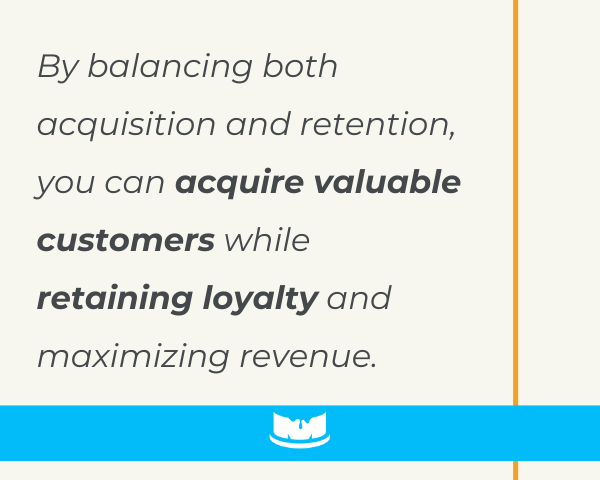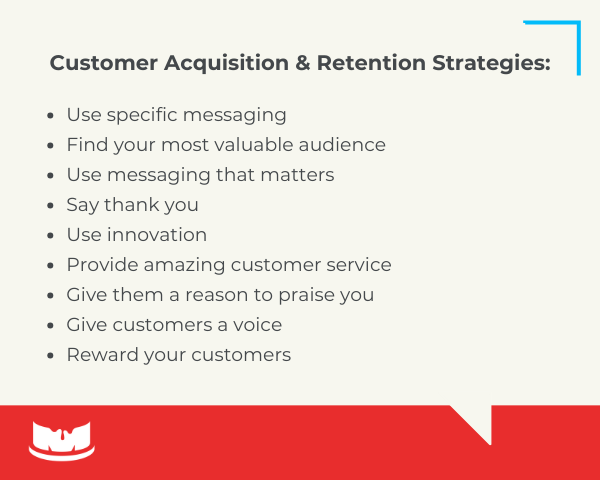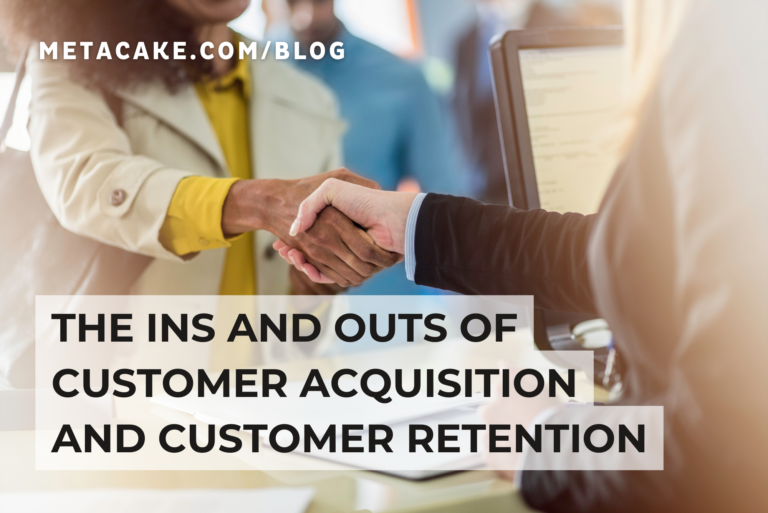One of the biggest challenges ecommerce business owners face is deciding whether to focus on gaining new customers or retaining the ones they currently have. The answer is quite simple: both!
As you’ve probably heard, it costs much less to keep current customers happy than to acquire new ones. Of course, in order to grow, you need a strong customer acquisition strategy. However, you need to have just as strong a plan for engaging with your existing customers.
What you really need is a balance between your customer acquisition and retention strategies.
Striking a balance between customer acquisition and customer retention is crucial for long-term success in a competitive ecommerce market.
In this article, we’ll go over the basics of what customer acquisition and customer retention are, which to focus on, and how to implement them.
What Is Customer Acquisition?
Customer acquisition is the process of acquiring and converting potential customers into paying customers. It’s essentially raising brand awareness and guiding prospects along the marketing funnel until they become paying customers.
Let’s look at why companies might focus on customer acquisition:
- Profit Boost: Acquiring new customers is essential for business success. Profits may be down, and new revenue sources need to be explored.
- Competitive Advantage: Companies target customer numbers and revenue to gain an edge over competitors.
- Cost Advantages: Higher customer numbers can lead to reduced costs and improved profit margins.
- New Product Launch: When introducing a new product or service to a fresh market, acquisition becomes a priority.
- Stakeholder Expectations: Investors expect growth, and acquisition remains a focal point.
- Sales and Marketing Incentives: Compensation structures often reward acquisition efforts.
What Is Customer Retention?
Customer retention is the process of nurturing and developing strong customer relationships through activities and techniques that drive repeat purchases.
The higher the customer retention rates, the more customers are satisfied with your product, and vice versa.
Let’s look at why companies might focus on customer retention:
- Cost-Effectiveness: Retaining existing customers is more cost-effective than acquiring new ones. Studies suggest that acquiring a new customer can cost five to ten times more than retaining an old one.
- Brand Loyalty: Trust in your brand leads to repeat purchases. Existing customers are more likely to buy when they trust your product due to good customer service or effective problem-solving.
- Marketing and Advertising Savings: Acquiring new customers involves expenses like marketing and advertising. Retaining customers requires less investment.
- Resource Efficiency: Converting leads into new customers demands significant resources, including sales and onboarding efforts.
- Targeted Campaigns: Existing customer data allows for more focused marketing efforts.
Keeping a Balance
Understanding each customer’s value to your business helps you make smarter investments. By balancing both acquisition and retention, you can acquire valuable customers while retaining loyalty and maximizing revenue.
By striking this balance between the two, you maintain a healthy equilibrium, which is crucial for sustainable growth.

How to Implement
In an ideal world, we’d tailor all experiences and messages specifically to each customer. This isn’t always possible, but as we learn more about customer behavior, we can implement a variety of strategies to make marketing more relevant for different groups.

1) Use Specific Messaging
There are a number of ways this could play out, whether you’re building Facebook ads or email templates. Here are a few examples:
- Segment customers who’ve bought from certain collections and speak to them about new products you’re adding to that collection.
- Win back unengaged customers by reminding them that they’re missed and filling them in on new products to hit your store.
- Separate your audience based on gender and then use slightly different imagery, style, or colors for male vs. female customers (yes, this small change will lift your CTR!).
- For those who have yet to purchase, continue messaging about the features and benefits of your product. Make it more powerful by ruling out concerns they might have or sharing customer testimonials.
2) Find Your Most Valuable Audience
When using customer segmentation, start by identifying your most valuable customers. How you identify these customers or define what’s “valuable” varies for different brands and products.
For example, if you’re a clothing brand that sells to men, women, and children, moms might be your most valuable customers to market to since moms tend to purchase for the whole family. If you sell silicone rings, married customers may have a higher value than single customers because they’re more likely to wear your rings.
The most valuable audience for your business depends on your specific business. Be sure to think about who makes the purchasing decisions; they may very likely be different from who your product is made for.
Useful Tools for Finding These Audiences
For most ecommerce businesses, the best place to find and segment current customers is using your email/CRM platform.
We’ve discussed our preference for Klaviyo for ecommerce email marketing at length, and that’s what we use to segment audiences. All your store data flows into the email platform, and you can quickly and easily find and segment your audience based on their actions.
Pro Tip: You can sync those segments you create with Facebook to retarget and create look-alike audiences to find more of those customers.
3) Use Messaging That Matters
Different types of customers value different features and benefits. If you want your message to resonate, focus on what makes your product great in the eyes of each customer you’re marketing to.
For example, one of our clients, Groove Life, sells silicone wedding rings for men and women. It’s essentially the same product, but men and women buy them for different reasons.
Men typically buy silicone rings because they find metal rings uncomfortable or dangerous for their lifestyle. Women tend to be less interested in the safety benefits and more motivated by the desire to look stylish while keeping their diamonds safe.
4) Say Thank You
This is where the “value” of the customer comes into play. Yes, everyone is important in their own way, but it’s not rocket science — customers who’ve made multiple purchases or customers who have a large sphere of influence are your most valuable people.
Say thank you to these customers by placing them on a “VIP List” and sending them special offers, early access to sales, sneak peeks of product releases, and more.
5) Use Innovation
A great product is a given, but don’t underestimate the importance of innovation as well. This’ll help maintain your authority as a forward-thinking leader in your industry. More importantly, it’ll also give your customers plenty of reasons to keep coming back.
6) Provide Amazing Customer Service
There’s immense value in having a team that shows your customers that they care about their experience. Click here to read more about the importance of customer service, especially in regard to creating fans of your brand.
7) Give Them a Reason to Praise You
Maintain your product quality (or, better yet, improve it). Stay honest and full of integrity as a company. Go above and beyond to make things right for your customers.
8) Give Customers a Voice
The most effective way to do this is through product and site reviews. This is a key trust-building element on your site, so new site visitors will feel good about purchasing from you.
9) Reward Them
If you’re on Shopify or Shopify Plus, one of the best rewards platforms is smile.io. They’re simple for customers to use and easy to implement in order to create a ton of value.
Outside of a rewards program, you can also “reward” your top customers by giving them exclusive access to special offers such as deeper discounts or gifts with purchases.
They could also receive early access to major sales. Treating your top customers like VIPs and communicating with them as if they’re “insiders” can help build trust and excitement and generate more sales.
Final Thoughts
Now that you know the importance of customer acquisition and retention and that finding the right balance between them is crucial for a business to thrive, are you ready to put them into action?
Don’t worry; you don’t have to face this alone. At Metacake, we’re here to help! Just reach out to our team to start a discussion on your next steps.
